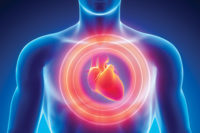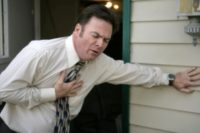Real-life stories of survival using AEDs

But unless you’ve been involved in an AED rescue or you or a loved one has been saved by an AED, it’s difficult to truly appreciate the power of these lifesaving devices. Every day, all over the country, people cheat death by mere minutes thanks to fast-responding bystanders and rescuers armed with AEDs. Here are some of their stories.
Easy-to-use AEDs turn bystanders into lifesavers
Two recent TV news stories illustrate the importance of speed and an easy-to-use AED in saving a victim of sudden cardiac arrest, America’s leading cause of death. Both Zach Young and Jim Breuel were saved by bystanders who quickly brought an AED to their aid and delivered life-saving shocks before EMS arrived.
Both individuals most likely would have died if an AED was not immediately available at the scene to save them, according to a CBS New York report on Young and a Fox Dallas-Fort Worth report on Breuel. About 90 percent of sudden cardiac arrest victims who receive shocks within the first minute after arrest survive, according to the Sudden Cardiac Arrest Association. However, the chances of survival decrease by 7 to 10 percent with each passing minute. After 10 minutes, less than 5 percent of victims survive.
A Johns Hopkins study published in the Journal of the American College of Cardiology emphasized the importance of speed. The authors found an average survival rate of 7 percent in a review of 13,759 out-of-hospital cardiac arrests. However, survival increased to 38 percent when patients received an AED shock before EMS arrival. Non-medical volunteers (Good Samaritan bystanders) operating an AED achieved the highest survival rate (40 percent), followed by healthcare workers (16 percent) and police (13 percent). “On average, early AED defibrillation before EMS arrival seems to nearly double a victim’s odds of survival,” the authors wrote.
Young was saved by two fellow roller hockey players and Breuel by two men working out near him in a fitness center. In both cases, the life savers were able to use Defibtech ReviveR™ AEDs quickly and confidently. To save Breuel, Kyle Smith and Alex Torda used the Defibtech ReviveR VIEW™ AED, a device that brings ease-of-use to a new level. The VIEW’s real-time video feature visually guides the user through each step of a rescue. The color video is reinforced by loud and clear audio and corresponding text that can be understood in noisy environments. For example, when the VIEW’s audio says and text reads, “Place pads on patient’s chest,” the video shows exactly where to place the pads.
Providing bystanders with easy-to-use AEDs is essential toward improving the sudden cardiac arrest survival rate, says Defibtech vice president Greg Slusser. “AEDs have approached a tipping point similar to when the iPhone revolutionized smart phones,” he said. Several years ago, most people were intimated by smart phones and AEDs. Now, improvements in the user interfaces of both devices make them very simple to operate, he explained.
Slusser said Defibtech developed the VIEW is response to survey data showing that video instruction would increase rescuers’ confidence. Without video, only about 50 percent of those surveyed expressed confidence in using an AED. So Defibtech and Harris Interactive asked the question: “What would give you greater confidence?” The answer? Video. With video, text and voice, 97 percent of the respondents said they would use an AED to save a life.
In the right airport at the right time
Logan International Airport in Boston may be one of the safest airports in the world — should you suffer sudden cardiac arrest (SCA) while traveling. Logan was one of the first airports to install automated external defibrillators (AEDs) as far back as 1996. More recently, the Massachusetts Port Authority (Massport), which owns and operates Logan, undertook a technology upgrade and installed over 170 ZOLL AED Plus® units throughout Logan and the other transportation facilities it operates in Massachusetts.
Today, Logan can boast that over the past year it has achieved a 75 percent survival rate from sudden cardiac arrest. “That’s triple the national average,” said Chief Robert Donahue, who heads Massport Fire and Rescue.
To date, over 50 percent of Logan’s workforce — some 8,000 employees — have been trained to use the AED Plus as part of Massport’s ongoing training program, which includes first aid, CPR and AEDs.
The AED Plus units are dispersed throughout the airport in high-volume areas at intervals that are no greater than a 90-second brisk walk. Signage is very conspicuous. When a cardiac arrest event is reported, a call goes out over the public address system signaling the victim’s location to the four EMS rescue stations at Logan; Massport Fire and Rescue mobilizes a rapid response ambulance crew to be at the scene in less than three minutes. From Logan, SCA victims can be transported to some of the best hospitals in the world within two minutes.
That systematic approach, and Boston’s robust hospital network, paid off in lifesaving dividends for 48-year-old computer programmer, Doug Hale, whose SCA was witnessed by two transportation security officers Massport had trained. Both TSA officers and a passenger, an off-duty police officer, jumped to his aid with CPR and an AED Plus. Fire dispatch arrived in three minutes, shocked Hale, and continued CPR. He was rushed to Massachusetts General Hospital, where he was treated with therapeutic hypothermia and then sent to rehab for a few weeks. After his recovery, Hale and his wife came back to Logan to publicly thank his rescuers for saving his life.
“What happened to me is testament to how critical having AEDs in public places can be,” said Doug Hale. “And having one that coaches rescuers with visual and audio prompts through a lifesaving event gives rescuers assurances when every second is vital.”
Doug’s wife, Tammy, a dental hygienist trained in CPR and AEDs, witnessed the event. “It seemed the rescuers were there almost immediately and hooked Doug up to the AED so fast. The AED Plus coached them every step of the way — where to place the electrodes, when the compressions weren’t deep enough. This was so critical because when you are usually doing compressions, you are blind to how effective they are.”
“Anyone could use this AED. It was so simple, not like the one I was trained on,” she added. “We’re grateful this happened in Boston because we might have had a different outcome if it had happened someplace else.”
Despite healthy living, heart trouble found her — twice
The weather that morning was miserable. Streets were slick with ice and more frozen rain and snow were falling. Conditions were so treacherous that the utility company Reymita “Reina” Walls works for allowed only vehicles with four-wheel drive to service the problems in Omaha, Neb.
Reina gripped the wheel and slogged through it all to get her daughter to school. Then she drove another 12 miles to work. As if the commute wasn’t taxing enough, Reina also was getting over a weekend wiped out by what she thought was a nasty flu bug and bronchitis.
When she finally reached her office building, Reina walked in and collapsed in the hallway with her coat on and her work bag still slung over her shoulder. The first person who saw her thought she’d slipped. Then he realized she wasn’t breathing.
A mother of two and grandmother of three, Reina worked out often, ate right and didn’t smoke. “The epitome of health,” one friend called her. Yet her appearance belied a serious problem: A clot had formed in the main artery of her heart, blocking her blood supply.
“I still had a strong heartbeat; the blood just wasn’t getting to the heart,” she said.
In the confusion that followed, someone called 9-1-1 and said Reina was dead. Other, calmer colleagues began a textbook case of CPR response. One person gave chest compressions while someone else went to get an AED. Another colleague trained in CPR took over the compressions. Just then, Reina expelled a huge amount of air.
The AED arrived soon after. The shock didn’t work, so they tried it again. As the paramedics entered the building, they heard the device say, “Shock delivered,” followed by another voice hollering, “We have a pulse!”
She couldn’t sustain it, though. A third AED jolt was needed in the ambulance.
Reina eventually had surgery to implant a tube called a stent to prop open the artery which provides blood flow to a significant amount her heart muscle.
Several months later, Reina was working out when she had trouble breathing. “No way could it be my heart again,” she thought. She called her cardiologist just to be sure. When an EKG showed no problems, it didn’t ease her mind. The doctor offered a stress test, but she requested a cardiac catheterization, a procedure that involves a thin, hollow tube going into the heart for a closer look. The catheterization uncovered another clot in the same place. Her body thought the stent was a foreign object and wanted to heal it by forming a blood clot, Reina said.
“The catheterization surgeons gave me the thumbs up during surgery,” she said. “The doctors told me it was a good call, and I was lucky again. I was more than lucky, I thought. I was blessed.”
Reina is now a devoted volunteer for the American Heart Association. She speaks anywhere and everywhere, especially to female audiences. More women die of heart disease than the next three causes of death combined, including all forms of cancer.
Reference
1) OSHA, Saving Sudden Cardiac Arrest Victims in the Workplace, http://www.osha.gov/Publications/3185.html
Looking for a reprint of this article?
From high-res PDFs to custom plaques, order your copy today!







.jpg?t=1721257160)